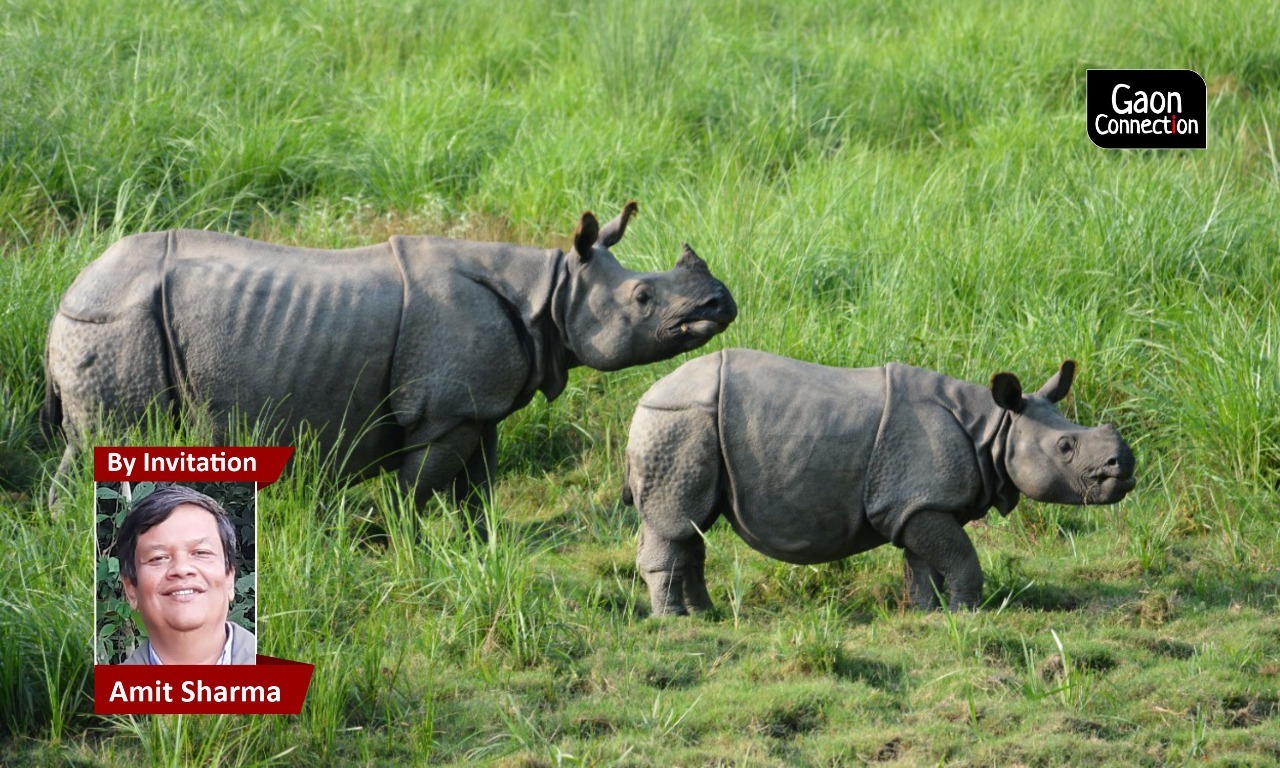The rhinos in the Indian Terai region at the foothills of the Himalayas that we see today have either arrived from Nepal or have been re-introduced through a strategically planned translocation programme. And the story of conservation translocation of these rhinos is no less than a blockbuster.
Through sustained efforts of the Government of India and the support extended by the governments of Assam and Uttar Pradesh, 40 rhinos now roam around Dudhwa in the Terai region of Uttar Pradesh.
It isn’t that the rhinos never inhabited the Terai region of India. Till around 1970, this region possessed earlier records of rhinos naturally occurring in areas around the present Dudhwa region, which were all believed to have been wiped out due to excessive poaching. But conservation translocation has helped reintroduce them.
Also Read: Even tigers get lonely, like RBT38 did, and head back to Ranthambore
In fact, the existing rhino population in Dudhwa demonstrates the impact of translocation as a successful conservation approach specially to restore locally extinct species in its original rangeland.
The rhinos of yore
The region that falls under the Terai Arc Landscape (TAL) is a trans-boundary landscape along the India-Nepal border stretching for more than 800 kilometres (kms) from river Yamuna in the west to Baghmati in the east in the Himalayan foothills offering continuous as well as connected habitats for wildlife to flourish.
Within the boundaries of India, the Terai region is spread over an area of more than 30,000 square km extending from the state of Uttarakhand in the west to Bihar in the east offering a rich biodiversity and providing a home to flagship species like the Bengal Tiger, Asian elephant and the rhinoceros.
William Daniell, a British landscape painter had confirmed the sighting of a rhino during his explorations at the Kotdwara area in 1789. Kotdwara is the western most limit of this landscape.
Later, the ranging of rhinos was reported in the Pilibhit region, which is located in the western part of Dudhwa, when British hunter R. Drummond killed the last rhino of the area in 1870. Further east, there were records of rhinos sightings at the Purnia and Champaran districts of Bihar.
There are records of rhinos being shot dead in Champaran district in 1939, and again in 1960. Records also suggest that a rhino was captured in the forests of Champaran district in Bihar in 1982, which had probably strayed in from Nepal.
Rhinos also existed extensively further south of the Terai belt along the banks of the river Ganges till they were locally exterminated due to the loss of habitat.
Also Read: It is World Tourism Day and Madhya Pradesh is rolling out the red carpet
Conservation translocations
As per IUCN, translocation involves the human mediated movement of living organisms from one area to be released in another area. Where these are planned keeping conservation to be the primary benefit, these movements are termed as conservation translocations.
After constant supervision, Dudhwa was found to be ready for reintroduction of rhinos, the first batch of which was moved from Assam in 1984.
As a part of the preparations in Dudhwa, an area of about 27 sq km was selected and enclosed by an electric fence for holding the rhinos in. The forest staff from Dudhwa were sent to Assam to be trained in monitoring and patrolling of the rhinos and for getting accustomed to the species behavior. A committee proposed translocation of 10 rhinos for the first trial to Dudhwa.
Also Read: The disappearing buffaloes of Bhadawar
A planned move
A plan was drawn up for the capture of the rhinos around the present day Pobitora Wildlife Sanctuary in Assam and the team successfully captured six individuals in March 1984 which consisted of one sub-adult female, two adult females and three adult males.
However, during the confinement period in a stockade facility post the capture, one big male escaped. The remaining five rhinos were moved to Dudhwa first by flight from Guwahati to Delhi and then by road to Dudhwa.
Once in Dudhwa they were allowed to adapt in the new area in stockades and then gradually allowed to move out to range in the enclosed area in April-May 1984. To strengthen the founder population another four female rhinos were brought from Chitwan National Park, Nepal in 1985.
Also Read: Why T4 is considered the queen of Panna Tiger Reserve
Of the nine rhinos reintroduced in Dudhwa in 1984-1985, two adult females that moved from Assam died within a short span leaving a founder population of seven rhinos that comprised of two adult males and the rest females within the enclosure.
Second rhino population reintroduced
Calf mortality due to diseases and tiger predation has been identified as key issues hampering normal growth of the rhino population in the enclosed area in Dudhwa.
To improve conservation in the state, a second population was set up in a second forest range within Dudhwa Tiger Reserve in 2018. Four rhinos, one male and three females, were captured in the first enclosure of Dudhwa to be reintroduced to a second enclosed area encompassing an area of around 14 sq km.
The same year, three female rhinos each gave birth to a calf which stamps the success of setting up another breeding rhino population in Uttar Pradesh.
Today, the population stands at around 40 individuals which is a huge success for rhino conservation in the country.
The forest department of Uttar Pradesh is also working closely with WWF India and other partners to set up rhino populations in other potential protected areas of the state.
It is also necessary that plans are put in place to free-range the existing rhino population within the enclosures in Dudhwa to provide the opportunity to mix and associate with the transient rhinos visiting from adjoining Nepal. This could foster a healthier environment for the rhino population to flourish.
Also Read: Birdsong, insect orchestra, the odd roar and a rare orchid
Action plan Bihar
In addition, the forest department of Bihar is working actively with WWF India and other partners to provide congenial habitats for natural colonisation of rhinos in the Valmiki Tiger Reserve on the India-Nepal border.
Over the last few years, rhinos have been moving to Valmiki Tiger Reserve from Nepal to use it as a temporary habitat. During the floods of 2017, ten rhinos visited from adjoining Nepal but all were allowed to be taken back keeping in view the security concerns associated with the species.
With a view to offer the opportunity to the rhinos to colonise naturally, there are interventions underway to improve the grassland habitats and also strengthen the security provisions. If the visiting rhinos decide to colonise permanently here, then this area will be added to the list of rhino-bearing areas in India.
The other option for Bihar would be to reintroduce a few rhinos through translocations as was done by Dudhwa earlier and more recently in Manas in Assam.
Also Read: The tigers of Madhya Pradesh may soon have a new address
Distribution and ranging of the rhinos in the Indian Terai is very limited, as it is presently found in viable numbers only in Dudhwa Tiger Reserve in the state of Uttar Pradesh. Sporadic sighting of rhinos is also reported in other areas like Katerniaghat, Pilibhit, Sohagi Barwa of Uttar Pradesh and Valmiki Tiger Reserve in Bihar.
Currently, this transboundary landscape has a total population of more than 750 unique rhino individuals of which around 40 are found within Dudhwa in India and the rest are mostly confined to Nepal with a few transient individuals seen in other parts of India both in Uttar Pradesh and Bihar.
Protecting a prehistoric species
Rhinos are a mega species that help engineer the grassland habitats for other smaller herbivores; it is also a prized prehistoric species as only very few areas in the globe can afford to support its existence as it demands very distinctive habitat qualities to endure.
Rhinos are also a big attraction among the tourists and can help improve the economies of the local population as well as the government if the opportunities provided by the existence of rhinos can be tapped into appropriately and adequately.
Also Read: Sulochana and Ayyub: The lovely bond between a jumbo and her mahout
Classic cases of rhino-dependent economies are to be seen in Kaziranga in Assam, Jaldapara in West Bengal as well as in the other smaller rhino bearing areas.
Communities can be directly benefited by providing them the opportunity to engage and set up enterprises that can be based on the existence of rhinos like it is in Nepal.
The entire Terai belt has enormous scope to promote conservation of rhinos by reintroducing them in the potential habitats. The respective state government with the support of the central government and other stakeholders can plan and execute a specialised programme in accordance with the objectives identified in the National Rhino Conservation Strategy adopted by the country in 2019.
Further rhinos can be the mascot for better transboundary cooperation between India and Nepal not only for conservation gains but also for promotion of tourism circuits in rhino landscapes and strengthening the economies of the citizens.
Amit Sharma is with Lead-Rhino Conservation, WWF India and has been working with the institute’s rhino- conservation work since 2015. He is based in Guwahati, Assam.
Views are personal.


















